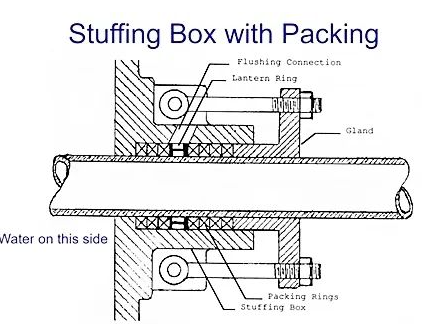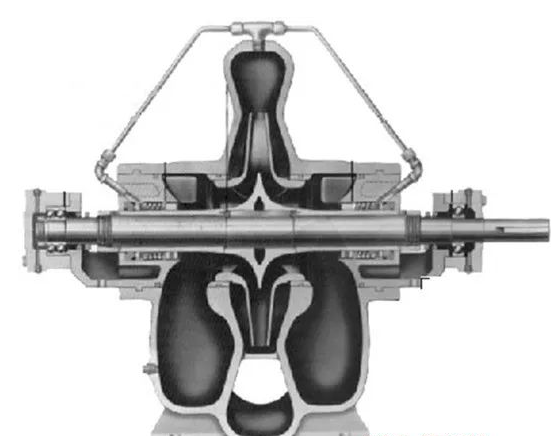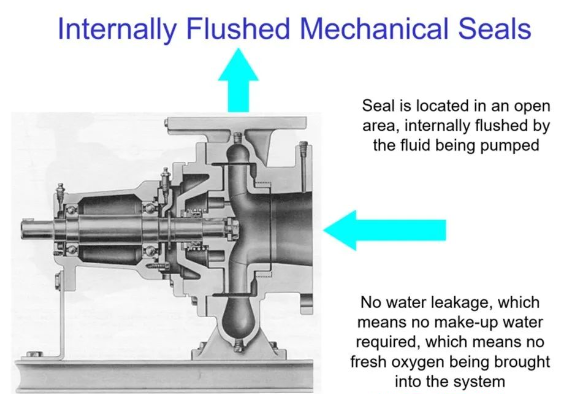
Centrifugal pump foundation: mechanical seals for internal and external flushing
Due to the friction between the packing and the shaft generating a large amount of heat, the packing seal requires a lot of lubrication. This lubrication is carried out through system water, which flows out from the outlet side of the pump, flushes the packing, and then discharges outside the pump. This forms an "open" system, which is a system that regularly uses and leaks flushing water. Water leakage is necessary and drips out of the pump at a rate of approximately one drop per second. Of course, these waters must be replaced with supplementary water, which means introducing more air into the system, thereby increasing corrosion.

In addition, the packing seal must be regularly adjusted by manually tightening the gland to maintain the correct amount of lubrication, which leads to excessive wear of the components. Decades ago, this type of seal was the standard configuration for most industrial pumps, and it is still in use in some industrial applications today.
Nowadays, mechanical seals have become the standard configuration for HVAC pumps. There is no type of leakage in the mechanical seal, but an integrated spring provides pressure against two highly polished sealing surfaces to seal the pump. Even competitors of B&G pumps, whose old-fashioned pump volute design has an external packing box, have been modified to use mechanical seals. That's why there are two types of pump mechanical seals in HVAC systems today - one designed for older pumps with external flushing lines, and the other is an internal flushing seal designed to mimic B&G.
Mechanical seals for external flushing and reasons to avoid:
The working principle of the external flushing seal is similar to other mechanical seals, but its design purpose is to be installed in the dry space of the pump casing/volute, just like the old packing seal. Therefore, they require external lubrication to prevent overheating caused by friction between the shaft and rotating and stationary sealing components. This lubrication is provided by capillary tubes, which transport water from the pump outlet to the mechanical seal, making the system a closed system compared to externally lubricated packing seals. This design has three drawbacks.
The first thing to consider is the size of the flushing pipeline. These pipes are usually 1/4 inch or 3/8 inch copper pipes. If the water quality begins to accumulate sediment in the pipeline or if there is on-site damage to the pipeline, it will limit the flushing flow rate. Compared to the flow rate designed by the manufacturer, reducing the flow rate will shorten the service life of the seal.
The second question is also related to water quality. The sealing surface is a highly polished surface. Any sand or gravel (solid particles) between the sealing surfaces can corrode the sealing surfaces, causing premature failure in mild cases and sealing leakage in severe cases.
The third issue is the amount of water to flush the seal to reduce heat accumulation caused by friction. The flow rate depends on the pressure difference between the inlet and outlet, as well as the friction loss of the pipeline. The pipeline size and flow rate designed by the manufacturer match the requirements of the pump. What happens when we install a variable speed drive on the pump? The suction pressure in a closed system remains relatively constant, but the discharge pressure will decrease. The flow rate varies with the square root of the pressure difference, and the flushing flow rate also decreases accordingly. This may not be a major issue in chilled water systems, but it may lead to a shortened seal life in heating systems.
The cross-sectional view below shows these pipelines located on both sides of a typical external mechanical seal (split double suction pump). Please note that they enter directly into the sealed packing box.

Internal flushing mechanical seal and its advantages
Like external flushing mechanical seals, internal flushing mechanical seals can also prevent water from flowing out of the pump housing and allow the pump shaft to rotate freely. However, the design of internal flushing mechanical seals is more complex and reliable.
The internal mechanical seal is located closer to the impeller of the pump and will be filled with water during startup. Therefore, they are essentially submerged in system water and exposed to approximately 25% of the pump fluid. This is very valuable because: 1) it does not require any external lubrication or pipelines; 2) The water flow velocity around the seal is higher, which can provide better flushing effect and prolong the service life of the seal.

In the external flushing seal, the pipeline directly applies all the required flushing fluid to the seal at a very high flow rate. And the internal flushing seal is essentially immersed in a bathtub filled with water. Why does this prolong the service life of the seal? Imagine that you are cleaning your grandmother's exquisite porcelain in the sink, and the water quality used for cleaning is very poor - there is a lot of sand in the water. Would you use a high-speed spray to clean it, or soak it in a sink and gently spin a towel around it? Just like porcelain, the replacement cost of centrifugal mechanical seals is also high, and they are often exposed to water containing a large amount of particles.
Although there are still pumps designed with external flushing seals, we recommend that you specify and require pumps with internal flushing mechanical seals for hydraulic HVAC systems, whether they are newly installed or replacing existing external sealed pumps. Internal flushing seals require less maintenance and help extend the pump's lifespan.
Categories
Recent Posts
Copyright © 2024 Tonglu Yongxin Valve Co.,Ltd.All Rights Reserved. Powered by dyyseo.com

IPv6 network supported